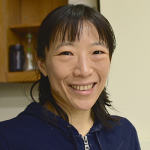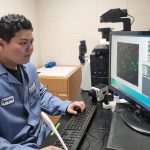Sangmoo Jeong Joins Johns Hopkins as New Faculty Member

While in college, Sangmoo Jeong never anticipated his career would take him from studying solar cells and batteries to metabolism and disease. Having already completed a bachelors and master’s degree in electrical engineering, he was well on his way to completing his PhD in the same field. In fact, Jeong was in his fourth year of research when he collaborated on a project with colleagues at Stanford University, inspiring him to change research directions in his postdoctoral fellowships.
“My PhD research is very different to what I am doing now. It was all about renewable energy devices, particularly solar cells. I am still working with cells, but with a different kind of cell now,” said Jeong.
Jeong’s nanofabrication expertise helped him achieve two major accomplishments while working on his PhD. The first was developing an ultra-thin, highly efficient silicon solar cell with his advisor, Yi Cui, professor of materials science and engineering at Stanford, which held the highest efficiency among ultra-thin devices in the world at that time. The second was the collaborative project with colleagues in the Department of Chemical and Systems Biology who wanted to study the mechanisms of how mechanical properties in the plasma membrane link to spatiotemporal localization of proteins in living cells and needed a device that could do so. The success of this project became the turning point in his research.
“My colleagues, even my research advisor, did not want me to get involved in biological research until after I finished my postdoctoral work and secured a faculty position. They were worried about me because I didn’t have a biology background and they didn’t want that to put me behind. But I saw it as a new adventure and thankfully I landed at a great lab at Harvard that helped me build my biology foundation,” said Jeong.
This new path landed Jeong a postdoctoral fellowship that bridged two organizations, Harvard Medical School (Massachusetts General Hospital) in Boston and Memorial Sloan Kettering Cancer Center in New York City. At Harvard, he created a device with sensitive biosensors that could detect metabolic signals that would go on to be used at Memorial Sloan. The joint project meant that at times, Jeong had to drive back and forth between Boston and New York City to work on his project.
“I learned a lot during my postdoc despite having to drive back and forth between Boston and New York City with heavy equipment in my car for the project. My colleagues were incredibly grateful to work with someone with my technical skills and they helped me learn a lot about biology and cancer research,” said Jeong.
As he joins Johns Hopkins, Jeong’s new laboratory will focus on developing sensitive technologies to further understand how dysfunctions in metabolism leads to disease manifestation and progression. This knowledge can help develop new ways to diagnose diseases early and make more effective treatments. For example, cancer cells are extremely adaptable to many metabolic conditions. If Jeong and his team can identify the mechanisms that make them so adaptable, they could identify a means to slow or stop them from proliferating.
In addition to being a core faculty member at the INBT, Jeong will have a primary appointment in the Department of Chemical and Biomolecular Engineering. Eventually, he hopes to establish a course in metabolism for engineers to better help students understand metabolism’s role in disease.
Jeong is passionate about research and spends a lot of time reading papers in other fields to find connections he would have otherwise over looked—a habit that he developed and learned from his PhD advisor. His technical education coupled with his training in the biomedical field has Jeong excited and prepared for the next steps in his research career.
Learn more about Sangmoo Jeong’s research
All-back-contact ultra-thin silicon nanocone solar cells with 13.7% power conversion efficiency
Integrated Magneto–Electrochemical Sensor for Exosome Analysis
High Fructose Drives the Serine Synthesis Pathway in Acute Myeloid Leukemic Cells





